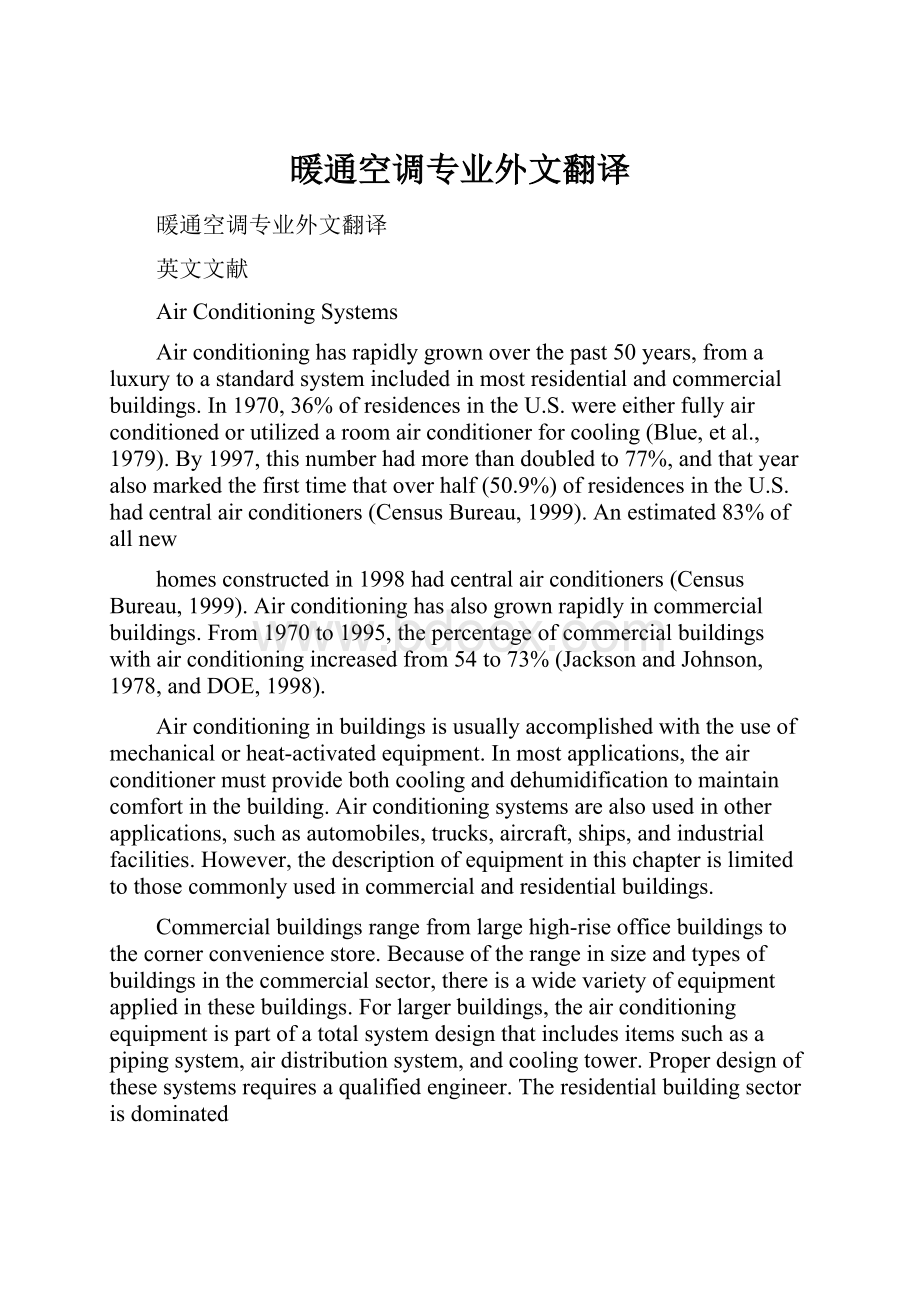暖通空调专业外文翻译.docx
《暖通空调专业外文翻译.docx》由会员分享,可在线阅读,更多相关《暖通空调专业外文翻译.docx(20页珍藏版)》请在冰豆网上搜索。

暖通空调专业外文翻译
暖通空调专业外文翻译
英文文献
AirConditioningSystems
Airconditioninghasrapidlygrownoverthepast50years,fromaluxurytoastandardsystemincludedinmostresidentialandcommercialbuildings.In1970,36%ofresidencesintheU.S.wereeitherfullyairconditionedorutilizedaroomairconditionerforcooling(Blue,etal.,1979).By1997,thisnumberhadmorethandoubledto77%,andthatyearalsomarkedthefirsttimethatoverhalf(50.9%)ofresidencesintheU.S.hadcentralairconditioners(CensusBureau,1999).Anestimated83%ofallnew
homesconstructedin1998hadcentralairconditioners(CensusBureau,1999).Airconditioninghasalsogrownrapidlyincommercialbuildings.From1970to1995,thepercentageofcommercialbuildingswithairconditioningincreasedfrom54to73%(JacksonandJohnson,1978,andDOE,1998).
Airconditioninginbuildingsisusuallyaccomplishedwiththeuseofmechanicalorheat-activatedequipment.Inmostapplications,theairconditionermustprovidebothcoolinganddehumidificationtomaintaincomfortinthebuilding.Airconditioningsystemsarealsousedinotherapplications,suchasautomobiles,trucks,aircraft,ships,andindustrialfacilities.However,thedescriptionofequipmentinthischapterislimitedtothosecommonlyusedincommercialandresidentialbuildings.
Commercialbuildingsrangefromlargehigh-riseofficebuildingstothecornerconveniencestore.Becauseoftherangeinsizeandtypesofbuildingsinthecommercialsector,thereisawidevarietyofequipmentappliedinthesebuildings.Forlargerbuildings,theairconditioningequipmentispartofatotalsystemdesignthatincludesitemssuchasapipingsystem,airdistributionsystem,andcoolingtower.Properdesignofthesesystemsrequiresaqualifiedengineer.Theresidentialbuildingsectorisdominated
bysinglefamilyhomesandlow-riseapartments/condominiums.Thecoolingequipmentappliedinthesebuildingscomesinstandard“packages”thatare
oftenbothsizedandinstalledbytheairconditioningcontractor.
Thechapterstartswithageneraldiscussionofthevaporcompressionrefrigerationcyclethenmovestorefrigerantsandtheirselection,followedbypackagedChilledWaterSystems。
1.1VaporCompressionCycle
Eventhoughthereisalargerangeinsizesandvarietyofairconditioningsystemsusedinbuildings,mostsystemsutilizethevaporcompressioncycletoproducethedesiredcoolinganddehumidification.Thiscycleisalsousedforrefrigeratingandfreezingfoodsandforautomotiveairconditioning.ThefirstpatentonamechanicallydrivenrefrigerationsystemwasissuedtoJacobPerkinsin1834inLondon,andthefirstviablecommercialsystemwasproducedin1857byJamesHarrisonandD.E.Siebe.Besidesvaporcompression,therearetwolesscommonmethodsusedtoproducecoolinginbuildings:
theabsorptioncycleandevaporativecooling.Thesearedescribedlaterinthechapter.Withthevaporcompressioncycle,aworkingfluid,whichiscalledtherefrigerant,evaporatesandcondensesatsuitablepressuresforpracticalequipmentdesigns.
Thefourbasiccomponentsineveryvaporcompressionrefrigerationsystemarethecompressor,condenser,expansiondevice,andevaporator.Thecompressorraisesthepressureoftherefrigerantvaporsothattherefrigerantsaturationtemperatureisslightlyabovethetemperatureofthecoolingmediumusedinthecondenser.Thetypeofcompressoruseddependsontheapplicationofthesystem.Largeelectricchillerstypicallyuseacentrifugalcompressorwhilesmallresidentialequipmentusesareciprocatingorscrollcompressor.
Thecondenserisaheatexchangerusedtorejectheatfromtherefrigeranttoacoolingmedium.Therefrigerantentersthecondenserandusuallyleavesasasubcooledliquid.Typicalcoolingmediumsusedincondensersareairandwater.Mostresidential-sizedequipmentusesairasthecoolingmediuminthecondenser,whilemanylargerchillersusewater.Afterleavingthecondenser,theliquidrefrigerantexpandstoalowerpressureintheexpansionvalve.
Theexpansionvalvecanbeapassivedevice,suchasacapillarytubeor
2
shorttubeorifice,oranactivedevice,suchasathermalexpansionvalveorelectronicexpansionvalve.Thepurposeofthevalveistoregulatetheflowofrefrigeranttotheevaporatorsothattherefrigerantissuperheatedwhenitreachesthesuctionofthecompressor.
Attheexitoftheexpansionvalve,therefrigerantisatatemperaturebelowthatofthemedium(airorwater)tobecooled.Therefrigeranttravelsthroughaheatexchangercalledtheevaporator.Itabsorbsenergyfromtheairorwatercirculatedthroughtheevaporator.Ifairiscirculatedthroughtheevaporator,thesystemiscalleda.Ifwateriscirculatedthroughdirectexpansionsystem
theevaporator,itiscalledachiller.Ineithercase,therefrigerantdoes
notmakedirectcontactwiththeairorwaterintheevaporator.Therefrigerantisconvertedfromalowquality,two-phasefluidtoasuperheated
vaporundernormaloperatingconditionsintheevaporator.Thevaporformedmustberemovedbythecompressoratasufficientratetomaintainthelowpressureintheevaporatorandkeepthecycleoperating.
Allmechanicalcoolingresultsintheproductionofheatenergythatmustberejectedthroughthecondenser.Inmanyinstances,thisheatenergyisrejectedtotheenvironmentdirectlytotheairinthecondenserorindirectlytowaterwhereitisrejectedinacoolingtower.Withsomeapplications,itispossibletoutilizethiswasteheatenergytoprovidesimultaneousheatingtothebuilding.Recoveryofthiswasteheatattemperaturesupto65?
C(150?
F)canbeusedtoreducecostsforspaceheating.
Capacitiesofairconditioningareoftenexpressedineithertonsorkilowatts(kW)ofcooling.Thetonisaunitofmeasurerelatedtotheabilityofaniceplanttofreezeoneshortton(907kg)oficein24hr.Itsvalueis3.51kW(12,000Btu/hr).ThekWofthermalcoolingcapacityproducedbytheairconditionermustnotbeconfusedwiththeamountofelectricalpower(alsoexpressedinkW)requiredtoproducethecoolingeffect.
2.1RefrigerantsUseandSelection
Upuntilthemid-1980s,refrigerantselectionwasnotanissueinmost
3
buildingairconditioningapplicationsbecausetherewerenoregulationsontheuseofrefrigerants.Manyoftherefrigerantshistoricallyusedforbuildingairconditioningapplicationshavebeenchlorofluorocarbons(CFCs)andhydrochlorofluorocarbons(HCFCs).Mostoftheserefrigerantsarenontoxicandnonflammable.However,recentU.S.federalregulations(EPA1993a;EPA1993b)andinternationalagreements(UNEP,1987)haveplacedrestrictionsontheproductionanduseofCFCsandHCFCs.Hydrofluorocarbons(HFCs)arenowbeingusedinsomeapplicationswhereCFCsandHCFCswereused.Havinganunderstandingofrefrigerantscanhelpabuildingownerorengineermakeamoreinformeddecisionaboutthebestchoiceofrefrigerantsforspecificapplications.Thissectiondiscussesthedifferentrefrigerantsusedinorproposedforbuildingairconditioningapplicationsandtheregulationsaffectingtheiruse.
TheAmericanSocietyofHeating,RefrigeratingandAirConditioningEngineers(ASHRAE)hasastandardnumberingsystem,foridentifyingrefrigerants(ASHRAE,1992).ManypopularCFC,HCFC,andHFCrefrigerantsareinthemethaneandethaneseriesofrefrigerants.Theyarecalledhalocarbons,orhalogenatedhydrocarbons,becauseofthepresenceofhalogenelementssuchasfluorineorchlorine(King,1986).
Zeotropesandazeotropesaremixturesoftwoormoredifferentrefrigerants.Azeotropicmixturechangessaturationtemperaturesasitevaporates(orcondenses)atconstantpressure.Thephenomenaiscalledtemperatureglide.Atatmosphericpressure,R-407Chasaboiling(bubble)pointof–44?
C(–47?
F)
andacondensation(dew)pointof–37?
C(–35?
F),whichgivesitatemperature
glideof7?
C(12?
F).Anazeotropicmixturebehaveslikeasinglecomponent
refrigerantinthatthesaturationtemperaturedoesnotchangeappreciablyasitevaporatesorcondensesatconstantpressure.R-410Ahasasmallenoughtemperatureglide(lessthan5.5?
C,10?
F)thatitisconsidereda
near-azeotropicrefrigerantmixture.
ASHRAEgroupsrefrigerantsbytheirtoxicityandflammability(ASHRAE,1994).GroupA1isnonflammableandleasttoxic,whileGroupB3isflammableand
4
mosttoxic.Toxicityisbasedontheuppersafetylimitforairborneexposuretotherefrigerant.Iftherefrigerantisnontoxicinquantitieslessthan400partspermillion,itisaClassArefrigerant.Ifexposuretolessthan400partspermillionistoxic,thenthesubstanceisgiventheBdesignation.Thenumericaldesignationsrefertotheflammabilityoftherefrigerant.ThelastcolumnofTable4.2.1showsthetoxicityandflammabilityratingofcommonrefrigerants.
Refrigerant22isanHCFC,isusedinmanyofthesameapplications,andisstilltherefrigerantofchoiceinmanyreciprocatingandscrewchillersaswellassmallcommercialandresidentialpackagedequipment.ItoperatesatamuchhigherpressurethaneitherR-11orR-12.RestrictionsontheproductionofHCFCswillstartin2004.In2010,R-22cannotbeusedinnewairconditioningequipment.R-22cannotbeproducedafter2020(EPA,1993b).
R-407CandR-410AarebothmixturesofHFCs.BothareconsideredreplacementsforR-22.R-407Cisexpectedtobeadrop-inreplacementrefrigerantforR-22.ItsevaporatingandcondensingpressuresforairconditioningapplicationsareclosetothoseofR-22(Table4.2.3).However,replacementofR-22withR-407Cshouldbedoneonlyafterconsultingwiththeequipmentmanufacturer.Ataminimum,thelubrican